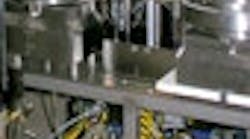Are You Experienced?
Jules MacGregor (right) and Jack Chopper test controls on a Filamatic machine. MacGregor has been with the company since its inception.
Source: FILAMATIC
“They started out with small tabletop manual fillers,” explains Rudy Arn, president and COO of Filamatic, still located in Baltimore, although the filling and packaging machine builder outgrew Rosen’s basement long ago.
A dramatic evolutionary step in the ’80s brought the Monobloc multi-stage filling and packaging machine to the forefront of the company’s machine series, but the true innovation at Filamatic could be its remarkable ability to retain employees. The Rosen family still owns the company, and MacGregor, the son, still works for him. “Our average tenure here is in the 20-plus-years range,” says Arn.
One of those employees, Jack Grosskopf, director of engineering, has seen a lot of change in his 23 years at Filamatic. “Fifteen years ago, a customer would come to us for a filler, and that customer would be his own integrator of the end capper,” he says. “They’re no longer capable of doing that. The devil’s in the details for the integration. When you link them together, that’s when there’s a problem.”
Filamatic’s customer pulled it into integration in the’90s, explains Arn. “What separates the men from the boys are the controls and having all these pieces talking to each other,” he says. “In our industry, you have the integrators and liquid filling experts. The better scenario is for the liquid-filling people to do the integration.”
Filamatic still manufactures the benchtop manual machines in addition to the automatic machine platforms. “Most of our automatic machines and Monobloc machines are index driven,” says Grosskopf. “All of those Microsoft Word-like commands can be used on our machines. Manual adjustments are electronic, and you can modify the operation of our equipment while it’s running. If message display or data accumulation is down, it will tell you why it’s down. We collect data on downtime so the customer can go back and address those. We’ve also recently incorporated remote diagnostics. We can log onto your machine from here.”
And Filamatic’s 15 engineers, mostly mechanical, are equipped to handle servo technology. “Our machines are primarily PLC-controlled,” explains Grosskopf. “I like to think we’re one of the more aggressive OEMs when it comes to servo technology. We’re not bashful or shy about linking sophisticated moves with servos. Those are all separate controls. We buy separate indexers which are not part of the PLC.”
Filamatic is driven by customer needs, and change is always a constant. Instead of a separate servo controller and PLC, one connection and HMI that displays all the information is one customer request Grosskopf is seeing more frequently. “The other thing that I’m seeing is safety and risk assessments,” he says. “Twenty years ago, we were primarily a mechanical house. We are progressing into more of an electrical house, in that a lot of those mechanical design requirements are being replaced.”
The market drives innovation, explains Arn. “The rate at which it’s driving is compounding,” he says. “They want more flexibility to be able to handle multiple commodities. We see a need to change product out—shampoos today and creams tomorrow and back to shampoos. It’s what the market is demanding. And the packaging equipment has to be more flexible to handle that.”
The direction Filamatic is headed with its new designs lead to fully integrated systems. “Once you have the container,” says Grosskopf, “don’t let it go.”




